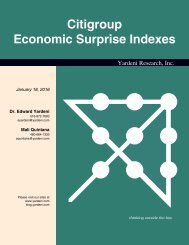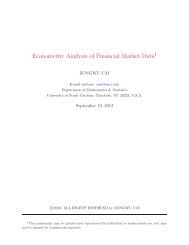Illiquid Asset Investing 1. Liquidating Harvard
Illiquid Asset Investing 1. Liquidating Harvard
Illiquid Asset Investing 1. Liquidating Harvard
You also want an ePaper? Increase the reach of your titles
YUMPU automatically turns print PDFs into web optimized ePapers that Google loves.
Andrew Ang <strong>Illiquid</strong> <strong>Asset</strong> <strong>Investing</strong> <strong>Asset</strong> Management<br />
large transaction costs and long times between trading – that have been captured in portfolio<br />
choice models with illiquid assets. 38<br />
5.1 <strong>Asset</strong> Allocation with Transactions Costs<br />
George Constantinides (1986) was the first to develop an asset allocation model where the<br />
investor had to pay transactions costs to trade. Selling $100 of equities, for example, results in a<br />
final position of $90 with 10% transactions costs. Not surprisingly, the investor trades<br />
infrequently – to save on transactions costs. Constantinides proved that the optimal strategy is to<br />
trade whenever risky asset positions hit upper or lower bounds. Within these bounds is an<br />
interval of no trading. The no-trading band straddles the optimal asset allocation from a model<br />
that assumes you can continuously trade without frictions (the Merton (1971) model). 39<br />
The no-trade interval is a function of the size of the transactions costs and the volatility of the<br />
risky asset. Constantinides estimates that even for transactions costs of 10%, there are no-trade<br />
intervals greater than 25% around an optimal holding of approximately 25% for a risky asset<br />
with a 35% volatility. (I bet <strong>Harvard</strong> wished it could have received just a 10% discount when it<br />
tried to sell its private equity investments.) That is, the asset owner would not trade between<br />
[0%, 50%] – indeed, very large fluctuations in the illiquid asset position. <strong>Illiquid</strong> asset investors<br />
should expect to rebalance very infrequently.<br />
Constantinides’ model can be used to compute an illiquidity risk premium, defined as the<br />
expected return of an illiquid asset required to bring the investor the same level of utility as in a<br />
frictionless setting. This is the risk premium the investor demands to bear the transactions costs<br />
and is a certainty equivalent calculation (see Chapter XX). For transactions costs of 15% or<br />
38<br />
Parts of this are based on Ang (2011) and Ang and Sorensen (2012).<br />
39<br />
Chapter XX discusses extensions of Constantinides (1986) to double bands, contingent bands, and rebalancing to<br />
the edge or center of the bands.<br />
32




